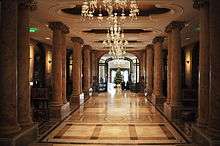Athenee Palace Hilton Bucharest
| Athenee Palace Hilton Bucharest | |
|---|---|
|
Athénée Palace Hilton Bucharest | |
 Location within Romania | |
| General information | |
| Coordinates | 44°26′27.6″N 26°05′44.9″E / 44.441000°N 26.095806°E |
| Opening |
1912 1997(Hilton Hotel) |
| Owner | Ana Hotels SA |
| Management | Hilton Hotels & Resorts |
| Height | 22.93m |
| Technical details | |
| Floor count | 6 |
| Design and construction | |
| Architect |
Duiliu Marcu Théophile Bradeau |
| Other information | |
| Number of rooms | 272 |
| Website | |
| Official website | |
Athenee Palace Hilton Bucharest is a historic luxury hotel in Bucharest, Romania opened in 1914. It was arguably Europe's most notorious den of spies in the years leading up to World War II, and only slightly less so during the Cold War.[1]
Location
Located in the heart of Bucharest on Str. Episcopiei at the corner of Calea Victoriei on the former site of the Han Gherasi[2] (Han is Romanian for "inn"), the hotel faces onto the small park in front of the Romanian Athenaeum on Revolution Square (originally Athenaeum Square, then Republic Square). It did not originally face onto a square: at the time the hotel was built, the space that is now a small park was occupied by the Splendid Hotel, destroyed by bombing on August 24, 1944, and there were a considerable number of other buildings on what is now the square.[3]
History

The Athénée Palace, designed by the French architect Théophile Bradeau, was built 1912–1914 in the Art Nouveau style. It was completely modernized 1935–1937 by Duiliu Marcu, with the exterior redesigned in the Art Deco style. It was the first building in Bucharest to use reinforced concrete construction.[4] Damaged by American air raids during World War II, in 1944, it was completely remodeled in 1945. A new wing was built behind the original hotel in 1965. The hotel's interiors were again remodeled in 1983. Again damaged in the Romanian Revolution of 1989 (some of whose worst violence occurred in the square immediately in front of the hotel), it was remodeled again by Hilton International in 1995–1997. The hotel was sold to Ana Hotels SA in 2005, but continues to be managed by Hilton.
Describing the hotel as it looked in 1938, A. L. Easterman of London's Daily Express and later of the Daily Herald referred to its "heavily ornate furnishings, marble and gold pillars, great glittering chandeliers, and the deep settees placed well back in the recesses of the lounge as if inviting conspiracy."[5]
New York Times foreign correspondent C. L. Sulzberger wrote in his memoir A Long Row of Candles that as World War II was approaching, he settled into the Athénée Palace "to enjoy my wait for war… This was a comfortable establishment with excellent service…a corrupt staff always seeking to change a customer's money at black-market rates, and continual competition by ladies of easy or nonexistent virtue to share the warmth of a client's bed."[6] "Countess" R. G. Waldeck wrote of the hotel in the same era, "Here was the heart of Bucharest, topographically, artistically, intellectually, politically—and, if you like, morally."[6] It was also home at the time to both British spies and the Gestapo.[1] A. L. Easterman called it the "most notorious caravanserai in all Europe. …the meeting place of the Continental spies, political conspirators, adventurers, concession hunters, and financial manipulators. "[5]
The hotel is a primary setting in Olivia Manning's Balkan Trilogy.,[7] which was later filmed as the 1987 BBC miniseries Fortunes of War, starring Kenneth Branagh and Emma Thompson. The miniseries was not shot at the hotel, but in Yugoslavia.
In 1948 the hotel was nationalized by the new Communist government, who famously bugged every room, tapped every phone (and every pay phone within half a mile), and staffed the entire hotel with informers. Dan Halpern writes, "The hotel's general director was an undercover colonel in the Securitate's Counterespionage Directorate; the hotel's deputy director was a colonel in the DIE, the Romanian external intelligence organization. The doormen did surveillance; the housekeeping staff photographed all documents in the guests' rooms. The prostitutes in the lobby and in the bar and in the nightclub reported directly to their employers; the free-speaking bons vivants and Romanian intellectuals hanging around the café, not to mention a number of the guests, had been planted."[1]
The hotel was extended in 1965; the new structure was built away from the street side. The project team, comprising architect Nicolae Pruncu and engineers Radu Mircea and Mihai Ionescu, encountered severe technical difficulties in what concerned the binding of the old building with the new one.[8]
The government-run Athénée Palace closed in 1994 and was bought at auction by Hilton International, who proceeded to do a $42 million renovation, reopening the hotel as the Athénée Palace Hilton Bucharest in 1997.[1]
Notes
References
- Easterman, A. L., King Carol, Hitler, and Lupescu, Victor Gollancz Ltd., London, 1942
- Constantin C. Giurescu, Istoria Bucureștilor. Din cele mai vechi timpuri pînă în zilele noastre, Ed. Pentru Literatură, Bucharest, 1966
- Institut Proiect București, Arta Grafică, Bucharest, 1968
- Dan Halpern, The Walls Have Ears, Travel and Leisure, June 2005
- List of Names and Places Explained: The Athenee Palace Hotel, the Splendid Hotel, in Bucharest Between the Wars: A Modernity With Fringes, Romanian Academy Library, accessed 4 January 2006.
- Cream of the Crop - Athenee Palace Hilton on InYourPocket.com. Accessed 1 March 2006
External links
| Wikimedia Commons has media related to Athenee Palace Hilton Bucharest. |
Coordinates: 44°26′27.71″N 26°5′43.90″E / 44.4410306°N 26.0955278°E